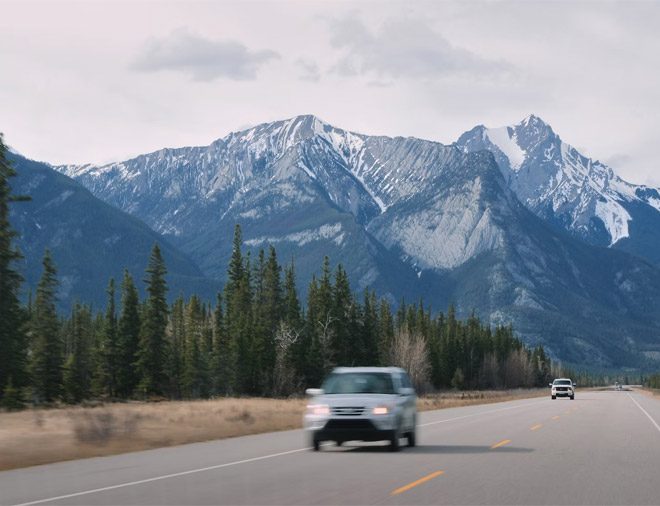Canada is a land of rich history, breathtaking beauty, and diverse cultures. And its vastness is easily perceived through its extensive network of roads. From the coastal routes that wander across the rugged shorelines to the well-built highways that pass through the mountainous regions, Canada’s road system promotes efficiency and safety. The country has the world’s longest national highway, known as the Trans-Canada Highway (TCH), which spans 4,850 miles, connecting the country’s ten provinces as well as the two oceans (Atlantic and Pacific).
What is more interesting is that Canada’s traffic system is entirely based on British driving standards, incorporating some regional variations. Proper measures are taken by the road and traffic authorities of Canada to deploy road speed limits and safety rules and regulations, especially when it comes to distracted driving, and drug, and alcohol usage. Having said that, if you regularly use Canada’s road systems for transportation and your current driving license is due for renewal, then you can use our guide to apply for one right away.
How to Renew License by Province
In Canada, driving licenses are usually issued by the authorities acting in a specific region or province in which the applicant resides. For instance, if the applicant resides in Alberta, then the government of Alberta will issue the driving license. This effectively showcases that there is no unified system for driving license renewals for all provinces, as each province carries out its own processes.
Applicants should also remember that the specific regulations relating to driver’s licenses will vary from one province or territory to another. For example, Alberta’s standard age for a learner’s permit is 14 years, while the same for British Columbia is 16 years. However, all Canadian provinces allow non-residents to use out-of-country licenses, licenses issued by other territories, and international driving permits. In addition to that, Canadian driving licenses are also valid to be used in specific other countries due to international treaties and agreements.
Now that you have a basic idea as to how the issuance of driving licenses (new or renewals) works in Canada, follow the below-mentioned steps for a seamless experience.

- Start by first heading over to the official website of the Canadian province where you reside (or where your driving license was originally issued): Alberta, British Columbia, Manitoba, New Brunswick, Newfoundland and Labrador, Northwest Territories, Nova Scotia, Nunavut, Ontario, Prince Edward Island, Quebec, Saskatchewan, and Yukon.
- On the landing page of the relevant province (that you have chosen), you will be provided with the steps you need to follow for your driving license renewal. Keep in mind that not all Canadian provinces support online applications. For instance, Nunavut only supports offline applications, while Ontario supports online as well as offline applications.
- Once you have completed the application, pay the requisite renewal fees. Again, the renewal fees vary from one Canadian province to another, so make sure you double-check the same.
- After successful payment, proceed to wait for your renewed driving license to arrive in the mail within the next few weeks.
Everything You Need To Know
The Canadian Government states that if you want to legally drive a car in Canada, you will need a driver’s license issued by the government of the territory or province where you reside. Your driving license should always be with you when you are driving, and doing so allows you to travel anywhere within the country.
The rules and regulations also state that if you are an immigrant and have a valid license from your home country, then you will be able to use it in Canada for a short moment after you arrive in Canada. So, make sure you check with the government of your relevant province or territory for more details. Additionally, as a foreign national, if you want to use a foreign driver’s license in Canada, you can also opt for an IDP, or International Driving Permit, in your home country.
The process of obtaining a driver’s license depends on the territory or province where you reside as well as your driving background. The process may include a written exam on the road rules along with one or two driving tests. You can also obtain driving lessons (paid lessons) before you appear for your practical test. And once you get your driver’s license, its expiration date will be printed on it, after which you will need to renew it.
For the uninitiated, Canada’s driving age is determined on a province-by-province basis. Each of Canada’s territories uses a GDL, or Graduated Driver Licensing System, for standard cars as well as light trucks to ensure the driver’s proficiency is maintained. Apart from Alberta, where the driving age starts at 14 years, all other provinces use 16 years as the threshold for offering learners’ driving licenses.
The driving license offered to individuals in Canada is further divided into various vehicle classes. Each class will represent a specific vehicle type, and this vehicle classification differs based on the province or territory where you live. For instance, if you live in Saskatchewan, ‘Class 1’ vehicles refer to power units, trucks, and semi-trailers. But if you live in Alberta, ‘Class 1’ vehicles refer to any motor vehicle except motorcycles.
Lastly, license revocations and suspensions are handled separately for each province or region. Some common driving offenses include impaired driving or dangerous driving, which are clubbed under criminal offenses (according to Canada’s Criminal Code). And prison sentences are provided to repeat offenders and drivers causing public harm.

